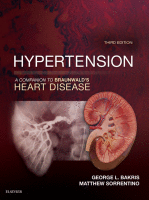Physical Address
304 North Cardinal St.
Dorchester Center, MA 02124

Elevated blood pressure (BP) remains an extraordinarily common and important risk factor for cardiovascular (CV) and renal diseases throughout the world. According to the 2011-2012 National Health and Nutrition Examination Survey (NHANES), around 70 million adult Americans (29%) have hypertension…

Hypertension-induced cardiovascular (CV) morbidity and mortality is caused by structural and functional alterations of the brain, heart, eyes, kidneys, and vasculature. Importantly, these hypertensive target organ damage (TOD) can be detected in an early subclinical stage, that is, as an…

For many years, clinicians have used diastolic blood pressure as the main risk indicator in hypertensive patients. However, several developments have caused a paradigmatic shift in our thinking about hypertension as a risk factor. First of all, the recognition from…

Our knowledge about the natural history of untreated hypertension is mainly based on historical information from a relatively short duration of time (1900s to 1970s). During that period, there was a significant evolution in the understanding of the health-related impact…

Over the past decade, there has been increasing interest in childhood hypertension and greater recognition that adult cardiovascular disease has its origins in childhood. Fueling this interest has been the childhood obesity epidemic, which has led to an increase in…

Obstructive Sleep Apnea and Hypertension Obstructive sleep apnea (OSA) and hypertension are common medical conditions which often coexist. Is there is a causal relationship between these two conditions? This question has been repeatedly raised in literature and has remained an…

Endocrine disorders account for about 5% to 10% of secondary hypertension. Pheochromocytoma and paraganglioma tumors are a well-established, albeit rare, cause of secondary hypertension. Pheochromocytomas and paragangliomas are tumors of the autonomic nervous system that arise from chromaffin tissue in…

Hypertension resulting from mineralocorticoid excess can be categorized based on levels of renin and aldosterone ( Box 14.1 ). Aldosterone, deoxycorticosterone, and cortisol are the three major mineralocorticoid receptor ligands. This chapter reviews the clinical presentation, diagnostic evaluation, and treatment…

Advances and Major Points of Emphasis 1. Definition of the spectrum of progressive clinical manifestations attributable to renovascular disease 2. Recognition that moderate reductions in renal blood flow do not induce tissue hypoxia or damage, thereby allowing ongoing medical therapy…

Traditionally, identification and management of hypertension has been based on office blood pressure (BP) measurements. However, after the introduction of methods to assess BP values under everyday life conditions, through either 24-hour ambulatory BP monitoring (ABPM) or home BP monitoring…